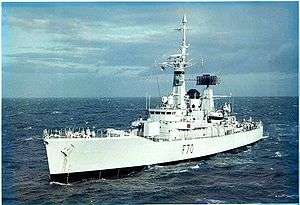HMS Apollo (F70)
 | |
| History | |
|---|---|
| Name: | HMS Apollo |
| Operator: | Royal Navy |
| Builder: | Yarrow Shipbuilders |
| Laid down: | 1 May 1969 |
| Launched: | 15 October 1970 |
| Commissioned: | 28 May 1972 |
| Decommissioned: | 31 August 1988 |
| Identification: | Pennant number: F70 |
| Fate: | Sold to Pakistan, 1988 |
| Name: | PNS Zulfiqar |
| Operator: | Pakistan Navy |
| Commissioned: | 1988 |
| Decommissioned: | 29 October 2006 |
| Identification: | Pennant number: F262 |
| Fate: | Sunk as target, 12 March 2010 |
| General characteristics | |
| Class and type: | Leander-class frigate |
| Displacement: |
|
| Length: | 372 ft |
| Beam: | 43 ft |
| Draught: | 18 ft |
| Installed power: | 30,000 shp (22,000 kW) |
| Propulsion: | 2 × steam turbines |
| Speed: | 28 kn (52 km/h) |
| Range: | 4,000 nautical miles at 15 kn |
HMS Apollo was a batch 3B broadbeam Leander-class frigate of the Royal Navy. She was, like the rest of the class, named after a figure of mythology. Apollo was built by Yarrow Shipbuilders of Scotstoun. She was launched on 15 October 1970 and commissioned on 28 May 1972, making her the penultimate Leander.
Both Apollo and Ariadne are easily distinguished from the other Leanders by their 'witches hat' - fitted to the top of the foremast as a part of the electronic warfare array.
Royal Navy Service
Apollo was fitted out as a general purpose frigate. Her armaments were: 2 × 4.5 inch (114mm) Vickers 45 Mk6 naval guns mounted in a single twin turret with MRS3/Plessey Type 904 gunnery control system; quadruple Seacat missile launcher platform with GWS22 guidance system; Mk10 anti-submarine triple barrel mortar tubes (auto-load, 92 kg warhead); Westland Wasp helicopter and two 20mm Oerlikon heavy machine guns.
She saw her first 'action' during the Second Cod War in 1973, during the fishing disputes with Iceland, when Apollo, while on a fishery protection patrol, was in collision with the Icelandic gunboat V/s Ægir on 29 August 1973.[1]
In January 1977 the UK extended its territorial waters from 12 miles to 200 miles to create an exclusive economic zone for fishery rights. Apollo took turns with other frigates to police the North Sea pending the introduction into service of the Island-class fishery protection vessels. This short action was termed 'The Herring War'.
In 1977, Apollo took part in the last Fleet Review of the Royal Navy so far, in celebration of HM the Queen's Silver Jubilee. As captain of the Second Frigate Squadron, Apollo was responsible for anchorages of all warships at the Royal Fleet Review. In recognition of this work, the admiralty awarded the ship four rather than two 1977 QEII Silver Jubilee Medals. Apollo was positioned in the middle of HM ships Hardy and Salisbury.[2]
Apollo was intended to be modernised, which would have included the removal of her one 4.5-inch twin gun, which would have been replaced by the Exocet anti-ship missile, but the modernisation was cancelled due to the 1981 Defence Review by the minister John Nott. In July 1982, Apollo was sent to patrol the South Atlantic in the aftermath of the Falklands War and returned home in September. In late 1983 Apollo once again returned to the South Atlantic. On this occasion Apollo encountered heavy seas in the South Atlantic that damaged her hull.
Sale to Pakistan
In 1988, Apollo's Royal Navy career came to an end when she was decommissioned and subsequently sold to Pakistan, being renamed PNS Zulfiqar. From 1991-93 she underwent a major refit and her 20mm guns and seacat system were replaced by twin 25mm mounts, and her Westland Wasp was replaced by an SA 319B Alouette III helicopter. Zulfiqar continued in service for 18 years with the Pakistan Navy until 29 October 2006 when she was decommissioned into training.
Fate
On Friday 12 March 2010, Zulfiqar was sunk as a target in the Arabian sea. Torpedoes and missiles were fired from an F-22P frigate, P3C aircraft and an Agosta 90B submarine.[3][4]
Commanding Officers
| From | To | Captain |
|---|---|---|
| 1971 | 1973 | Captain Richard Garnons-Williams RN |
| 1973 | 1974 | Captain Richard Fitch RN |
| 1977 | 1977 | Captain George Vallings RN |
| 1978 | 1979 | Captain J W F Briggs RN |
| 1984 | 1986 | Commander Jeremy De Halpert RN |
References
- ↑ Critchley 1986, p. 132.
- ↑ Official Souvenir Programme, 1977. Silver Jubilee Fleet Review, HMSO
- ↑ "China's sale of the first ship of the Pakistani Army F-22P warships". Sina. Retrieved 29 May 2012.
- ↑ "HMS Apollo sunk.".
Publications
- Colledge, J. J.; Warlow, Ben (2006) [1969]. Ships of the Royal Navy: The Complete Record of all Fighting Ships of the Royal Navy (Rev. ed.). London: Chatham Publishing. ISBN 978-1-86176-281-8. OCLC 67375475.
- Critchley, Mike (1986). British Warships Since 1945: Part 5 Frigates. Liskeard, UK: Maritime Books. ISBN 0-907771-13-0.
- Marriott, Leo (1983). Royal Navy Frigates 1945-1983. Shepperton, Surrey, UK: Ian Allen. ISBN 0-7110-1322-5.
- Osborne, Richard; Sowdon, David (1990). Leander Class Frigates. Kendal, UK: World Ships Society. ISBN 0-905617-56-8.